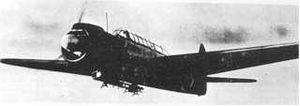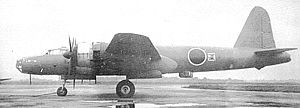The Nakajima B3N was a prototype Japanese carrier-based torpedo-bomber aircraft of the 1930s. A single-engined biplane with a crew of three, it was unsuccessful...
6 KB (469 words) - 16:04, 21 November 2023
The Nakajima Aircraft Company (中島飛行機株式会社, Nakajima Hikōki Kabushiki Kaisha) was a prominent Japanese aircraft manufacturer and aviation engine manufacturer...
14 KB (1,423 words) - 07:24, 23 August 2024
The Nakajima B5N (Japanese: 中島 B5N, Allied reporting name "Kate") was the standard carrier-based torpedo bomber of the Imperial Japanese Navy (IJN) for...
16 KB (1,837 words) - 08:58, 7 November 2024
The Nakajima Ki-43 Hayabusa (隼, "Peregrine falcon"), formal Japanese designation Army Type 1 Fighter (一式戦闘機, Ichi-shiki sentōki) is a single-engine land-based...
37 KB (4,215 words) - 07:05, 25 September 2024
The Nakajima A4N was a carrier-based fighter used by the Imperial Japanese Navy, and the last biplane designed by Nakajima. The first prototype was completed...
7 KB (726 words) - 19:01, 9 September 2024
The Nakajima Ki-84 Hayate (キ84 疾風, lit. "Gale") is a single-seat fighter flown by the Imperial Japanese Army Air Service in the last two years of World...
22 KB (2,583 words) - 00:38, 2 October 2024
The Nakajima Ki-116 was a late-World War II aircraft developed for the Imperial Japanese Army Air Force. It was essentially a Ki-84 Hayate with the Nakajima...
5 KB (578 words) - 01:19, 8 September 2024
The Nakajima J1N1 Gekkō (月光, "Moonlight") is a twin-engine aircraft used by the Imperial Japanese Navy during World War II. A prototype first flew in May...
13 KB (1,654 words) - 03:01, 3 October 2024
The Nakajima G5N Shinzan (深山, "Deep Mountain") was a four-engined long-range heavy bomber designed and built for the Imperial Japanese Navy prior to World...
10 KB (973 words) - 20:33, 6 October 2024
The Nakajima B6N Tenzan (天山, Tenzan, "Heavenly Mountain"; Allied reporting name: "Jill") was the Imperial Japanese Navy's standard carrier-borne torpedo...
21 KB (2,506 words) - 16:20, 14 November 2024
The Nakajima Ki-201 Karyū (中島 キ201 火龍, "Fire Dragon") was a Japanese jet fighter aircraft-attack aircraft project designed during the final stages of World...
6 KB (501 words) - 00:45, 8 September 2024
The Nakajima Kikka (橘花, "tachibana orange blossom"), initially designated Kōkoku Nigō Heiki (皇国二号兵器, "Imperial Weapon No. 2"), is Japan's first turbojet-powered...
15 KB (1,868 words) - 19:32, 14 October 2024
The Nakajima E8N was a Japanese ship-borne, catapult-launched, reconnaissance seaplane of the Second Sino-Japanese War. It was a single-engine, two-seat...
8 KB (792 words) - 07:00, 7 October 2024
The Nakajima Ki-49 Donryu (呑龍, "Storm Dragon") was a twin-engine Japanese World War II heavy bomber. It was designed to carry out daylight bombing missions...
10 KB (1,283 words) - 21:18, 6 October 2024
The Nakajima G10N Fugaku (Japanese: 富岳 or 富嶽, "Mount Fuji") was a planned Japanese ultra-long-range heavy bomber designed during World War II. It was conceived...
8 KB (832 words) - 20:46, 15 November 2024
The Nakajima Ki-44 Shoki (鍾馗, "Devil Queller") was a single-seat fighter-interceptor which was developed by the Nakajima Aircraft Company and operated...
21 KB (2,619 words) - 19:41, 14 November 2024
The Nakajima Ki-27 (九七式戦闘機, Kyūnana-shiki sentōki, Type 97 Fighter) was the main fighter aircraft used by the Imperial Japanese Army Air Service up until...
20 KB (2,492 words) - 09:48, 3 October 2024
The Shōwa L2D and Nakajima L2D, given the designations Shōwa Navy Type 0 Transport and Nakajima Navy Type 0 Transport(零式輸送機), were license-built versions...
20 KB (2,230 words) - 17:33, 25 September 2024
The Nakajima Ki-87 was a Japanese prototype high-altitude fighter-interceptor of World War II. It was a single seat, exhaust-driven turbo-supercharged...
8 KB (857 words) - 02:38, 12 September 2024
The Nakajima J5N was an abandoned Japanese prototype fighter aircraft of the World War II era. J5N was developed as twin-engine interceptor for countering...
7 KB (795 words) - 11:09, 8 September 2024
The Nakajima A6M2-N (Navy Type 2 Interceptor/Fighter-Bomber) was a single-crew floatplane based on the Mitsubishi A6M Zero Model 11. The Allied reporting...
8 KB (820 words) - 23:00, 9 September 2024
The Nakajima Ki-115 Tsurugi (剣, "sabre") is a one-man kamikaze aircraft that was developed by the Imperial Japanese Army Air Force during the closing stages...
10 KB (1,064 words) - 01:19, 8 September 2024
491. Mikesh & Abe 1990, pp. 224–225. Mikesh & Abe 1990, pp. 225–226. "Nakajima A2N". Mikesh & Abe 1990, pp. 232–233. Mikesh & Abe 1990, pp. 230–231. Mikesh...
54 KB (1,359 words) - 23:14, 21 October 2024
List of aircraft (N) (section Nakajima)
Nakajima RZ Nakajima S Nakajima Y3B Nakajima YM Nakajima A1N Nakajima A2N Nakajima A3N Nakajima A4N Nakajima A6M2-N Nakajima B3N Nakajima B4N Nakajima B5N Nakajima...
57 KB (5,660 words) - 19:59, 21 October 2024
The Nakajima Type 91 fighter was a Japanese fighter aircraft of the 1930s. It was a single-engine, single-seat parasol monoplane with a fixed, tailskid...
6 KB (580 words) - 02:44, 12 September 2024
The Nakajima G8N Renzan (連山, "Mountain Range") was a four-engined long-range bomber designed for use by the Imperial Japanese Navy. The Navy designation...
8 KB (856 words) - 11:26, 11 November 2024
The Nakajima A2N or Navy Type 90 Carrier Fighter was a Japanese carrier-borne fighter of the 1930s. It was a single-engined biplane of mixed construction...
9 KB (941 words) - 02:38, 12 September 2024
Douglas DC-4E (redirect from Nakajima LXD-1)
into the Nakajima G5N bomber after the single DC-4E prototype was sold to a Japanese airline and clandestinely dismantled for study by Nakajima at the behest...
8 KB (982 words) - 16:00, 22 October 2024
The Nakajima C6N Saiun (彩雲, "Iridescent Cloud") is a carrier-based reconnaissance aircraft used by the Imperial Japanese Navy Air Service in World War...
14 KB (1,621 words) - 02:51, 14 September 2024
The Nakajima A1N, or Navy Type 3 Carrier Fighter, was a Japanese carrier-based fighter of the late-1920s and early-1930s. It was a licensed copy of the...
8 KB (936 words) - 02:36, 11 September 2024


























